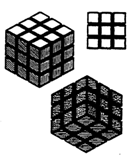In a dispute that has been ongoing for thirteen years, is this now the final twist? Following a decision of the EU Court of Justice in 2016, in which it confirmed the approach to take in relation to an objection that the essential characteristics of a shape are necessary to obtain the technical result of a product, the General Court has upheld a decision that the Rubik's Cube trade mark registration is invalid.
Whilst the makers of the Rubik's Cube puzzle reiterate that it continues to be protected by other 2D and 3D marks, the ruling illustrates the considerable difficulty in obtaining or maintaining trade mark protection for shape marks, particularly where they have a technical function. However, the arguably inconsistent application of the law by the Courts makes the position uncertain. For example, whilst Lego's EU trade mark for its studded brick fell foul of the technical result exclusion (because the brick achieved the technical result of stacking bricks), its trade mark for its mini figurines (with features which enable interlocking with other Lego products, such as bricks) did not.
Background
In 1996, Seven Towns applied to register the shape of the Rubik's cube as an EUTM for "three dimensional puzzles" in class 28.

In 2006, Simba Toys filed an application for a declaration of invalidity against the EUTM on a number of grounds. In particular, it argued that the mark consisted exclusively of the shape of the goods which is necessary to achieve a technical result (contrary to Article 7(1)(e)(ii) of the EU Trade Mark Regulation).
Simba's application of invalidity was rejected at all levels but, on its appeal to the CJEU, in 2016 it decided that the wrong test had been applied: "it was necessary to take into account the technical function of the actual goods represented by the sign in order to examine the functionality of the essential characteristics". In particular, when examining functional characteristics, it was necessary to look at the mark as represented graphically, but the analysis could go beyond that to consider circumstances and materials other than the graphical representation of the mark, such as the rotating capability of the Rubik's Cube puzzle. We discussed the CJEU's decision in our 18 November 2016 bulletin.
The CJEU therefore referred the case back to the EUIPO Board of Appeal, which declared the mark invalid. This latest decision of the General Court concerns the appeal by Rubik's Brand (which now owns the rights).
The General Court Decision
The General Court upheld the finding of invalidity. In particular, it concluded that the exclusion may apply where the graphical representation does not reveal all of the elements of the shape which are necessary to implement the technical solution, provided that implementation of the technical solution cannot be effective without the essential characteristics which are visible in the representation. The General Court noted that any other finding would mean that the technical result objection could be easily circumvented; as an applicant could simply omit from the graphical representation a characteristic which is necessary to achieve the technical result. This would enable an indefinite monopoly on technical solutions which are not, or are no longer, protected by a patent or design.
Comment
The General Court's decision was perhaps inevitable following the CJEU's guidance on the application of the technical result objection to the Rubik's Cube trade mark. It reflects the clear policy objective of ensuring that the trade mark system does not grant an indefinite monopoly on technical solutions or functional characteristics of a product. Such innovations should be protected, the policy argument goes, through other IP rights, such as patents or designs, which offer a more limited period of protection.
For Rubik's Brand, the clear concern is that competitors will release cheaper imitation products into the market, although it has stressed that the Rubik’s Cube puzzle continues to be protected by other 2D and 3D figurative trade marks.